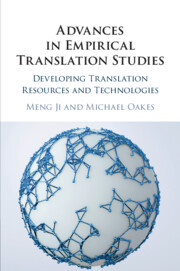Book contents
- Advances in Empirical Translation Studies
- Advances in Empirical Translation Studies
- Copyright page
- Contents
- Figures
- Tables
- Contributors
- Preface
- 1 Advances in Empirical Translation Studies
- 2 Development of Empirical Multilingual Analytical Instruments
- 3 Statistics for Corpus-Based and Corpus-Driven Approaches to Empirical Translation Studies
- 4 The Evolving Treatment of Semantics in Machine Translation
- 5 Translating and Disseminating World Health Organization Drinking-Water-Quality Guidelines in Japan
- 6 Developing Multilingual Automatic Semantic Annotation Systems
- 7 Leveraging Large Corpora for Translation Using Sketch Engine
- 8 Developing Computerised Health Translation Readability Evaluation Tools
- 9 Reordering Techniques in Japanese and English Machine Translation
- 10 Audiovisual Translation in Mercurial Mediascapes
- 11 Exploiting Data-Driven Hybrid Approaches to Translation in the EXPERT Project
- 12 Advances in Speech-to-Speech Translation Technologies
- 13 Challenges and Opportunities of Empirical Translation Studies
- Index
- References
8 - Developing Computerised Health Translation Readability Evaluation Tools
Published online by Cambridge University Press: 10 June 2019
- Advances in Empirical Translation Studies
- Advances in Empirical Translation Studies
- Copyright page
- Contents
- Figures
- Tables
- Contributors
- Preface
- 1 Advances in Empirical Translation Studies
- 2 Development of Empirical Multilingual Analytical Instruments
- 3 Statistics for Corpus-Based and Corpus-Driven Approaches to Empirical Translation Studies
- 4 The Evolving Treatment of Semantics in Machine Translation
- 5 Translating and Disseminating World Health Organization Drinking-Water-Quality Guidelines in Japan
- 6 Developing Multilingual Automatic Semantic Annotation Systems
- 7 Leveraging Large Corpora for Translation Using Sketch Engine
- 8 Developing Computerised Health Translation Readability Evaluation Tools
- 9 Reordering Techniques in Japanese and English Machine Translation
- 10 Audiovisual Translation in Mercurial Mediascapes
- 11 Exploiting Data-Driven Hybrid Approaches to Translation in the EXPERT Project
- 12 Advances in Speech-to-Speech Translation Technologies
- 13 Challenges and Opportunities of Empirical Translation Studies
- Index
- References
Summary
Health translation readability assessment represents an important yet largely underexplored research area in translation studies. This chapter introduces an integrated analytical system developed for the computer-aided assessment of the readability of Chinese health translations. The system comprises two components which are a computerised Chinese text lexical profile analyser; and a data-driven statistical instrument that can be used to diagnose and label the readability level of Chinese translations and non-translated health education materials. The online Chinese lexical profile analyser was informed by recent research in corpus linguistics and Chinese educational literacy. It includes thirty-nine individual and compound lexical features to enable in-depth and systematic analyses of the lexical complexity and textual coherence of Chinese health education and promotion materials. The statistical instrument was developed using a large Australian Chinese Health Translation Corpus. The statistical instrument built contains two measurement scales which are related to the information load and the lexical technicality as two important indicators of the readability of Chinese health education resources. The study demonstrated the viability and effectiveness of developing digital analytical tools and instruments for the objective assessment of the readability of health materials, especially health translations which hold the key to the success and sustainability of health promotion and communication in multicultural societies with diverse population groups.
- Type
- Chapter
- Information
- Advances in Empirical Translation StudiesDeveloping Translation Resources and Technologies, pp. 145 - 163Publisher: Cambridge University PressPrint publication year: 2019



